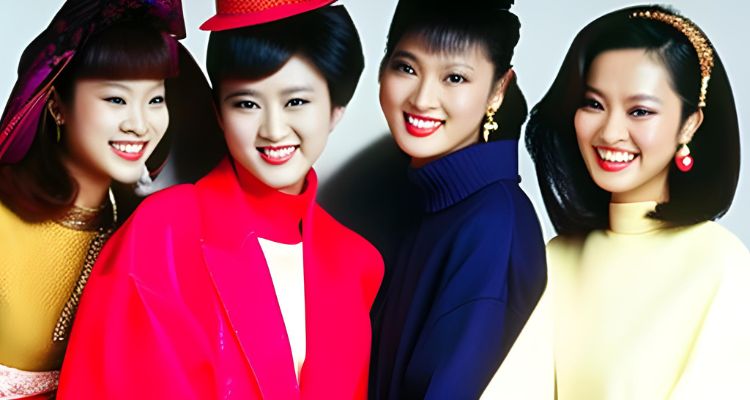Asian fashion experienced a crucial period in the 1990s. Designers from all across Asia pushed boundaries and laid the road for the future of fashion during this period of invention and inventiveness. We will examine the major Asian fashion fads and designers from the 1990s that transformed the market in this thorough guide. We will examine the salient characteristics of 90s Asian fashion as well as the regional variations that contributed to its dynamic and diversified landscape. We will examine how 90s Asian fashion has influenced the industry today, from the influence of pop culture to the designers that left their imprint.

Overview of 90s Asian Fashion Trends
The 1990s marked a significant period for fashion in Asia. It was a time of innovation and experimentation, where designers pushed boundaries and challenged conventional fashion norms. Some of the key fashion trends that emerged during this period include oversized and boxy silhouettes, vibrant colors and prints, bold logos and graphics, and edgy streetwear.
Oversized and boxy silhouettes were a key trend in the 90s Asian fashion scene. Loose-fitting clothing that draped the body was popular among both men and women. This trend was a departure from the more form-fitting styles of the 80s and represented a shift towards more relaxed and comfortable clothing.

Vibrant colors and prints were also a hallmark of 90s Asian fashion. Bold hues like hot pink, neon green, and bright orange were often paired together to create eye-catching and playful looks. Patterns such as plaid, floral, and animal prints were also popular.
Logos and graphics were other key trends in 90s Asian fashion. Many brands incorporated their logos into their designs, creating a sense of brand loyalty and identity. Bold graphics and typography were also used to create attention-grabbing designs.
Finally, the 90s saw the emergence of edgy streetwear, which was characterized by a mix of sportswear, military-inspired clothing, and punk aesthetics. This trend was popularized by Japanese streetwear brands such as A Bathing Ape and Undercover and continues to be a prominent trend in Asian fashion today.
Overall, the 90s Asian fashion scene was a vibrant and exciting time, characterized by bold and innovative trends that challenged the status quo.
Popular Asian Designers of the 90s
The 1990s marked the rise of many influential Asian fashion designers who pushed the boundaries of fashion and paved the way for future generations. Here are some of the most notable designers of the time:
- Rei Kawakubo – The founder of Comme des Garçons, Rei Kawakubo was known for her avant-garde designs that challenged conventional fashion norms. Her designs were often asymmetrical, oversized, and featured unusual silhouettes. She was a major influence on the Japanese fashion scene and continues to be a leading figure in the industry today.
- Yohji Yamamoto – Another Japanese designer, Yohji Yamamoto was known for his deconstructed, oversized clothing. He played with textures and fabrics, often incorporating unexpected materials into his designs. His work was seen as a rejection of the flashy and glamorous styles of the time and instead focused on a more subdued and intellectual aesthetic.
- Vivienne Tam – Born in Hong Kong, Vivienne Tam is known for her fusion of East and West in her designs. She drew inspiration from traditional Chinese motifs and combined them with contemporary Western silhouettes. Her work was a refreshing take on the fusion of cultures and helped to bridge the gap between Eastern and Western fashion.
- Issey Miyake – A Japanese designer, Issey Miyake was known for his innovative use of fabric and textiles. He often incorporated pleating and folding techniques to create unique shapes and silhouettes. He also experimented with technology, developing fabrics that were wrinkle-resistant and easy to care for. His designs were both functional and artistic, and continue to be influential today.
- Anna Sui – A Chinese-American designer, Anna Sui’s designs were a mix of vintage and punk aesthetics. Her work was playful and eclectic, often featuring bright colors and bold prints. She was known for her attention to detail and her ability to create a cohesive and unique aesthetic.
These designers and many others helped to shape the 90s Asian fashion scene, and their influence can still be seen in fashion today. They brought a new level of creativity and innovation to the industry, and their legacy continues to inspire new generations of designers.
Key Elements of 90s Asian Fashion
The 1990s marked a significant era for Asian fashion, where designers pushed boundaries and created new and innovative trends. Several key elements characterized 90s Asian fashion, including:
- Androgyny – Gender fluidity was a prominent theme in 90s Asian fashion. Many designers experimented with blurring gender lines, creating unisex designs that challenged traditional gender norms. This was seen in the oversized and boxy silhouettes that were popular during the time and in the use of androgynous models on the runway.
- Streetwear – The 90s saw the emergence of streetwear as a significant trend in Asian fashion. A mix of sportswear, military-inspired clothing, and punk aesthetics characterized Streetwear. This trend was popularized by Japanese streetwear brands such as A Bathing Ape and Undercover and has continued to be a prominent trend in Asian fashion today.
- Fusion of East and West – Many designers drew inspiration from both Eastern and Western cultures in their designs. This fusion of cultures was seen in the use of traditional Chinese motifs on contemporary Western silhouettes, as well as in the incorporation of Western pop culture references in Asian designs.
- Playful Colors and Prints – Vibrant colors and bold prints were a hallmark of 90s Asian fashion. Neon colors like hot pink, bright orange, and neon green were often paired together to create playful and eye-catching looks. Patterns such as plaid, floral, and animal prints were also popular.
- Technical Innovation – The 90s saw many designers experimenting with new fabrics and textiles, as well as with new construction techniques. This led to the development of wrinkle-resistant fabrics, easy-to-care-for garments, and innovative construction methods that created unique and unconventional silhouettes.

Overall, the key elements of 90s Asian fashion were characterized by creativity, innovation, and a willingness to push boundaries. The fusion of cultures, the experimentation with new techniques and materials, and the blurring of gender lines all helped to create a vibrant and exciting fashion scene that continues to inspire new generations of designers today.
Regional Differences in 90s Asian Fashion
While there were certainly common trends and elements in 90s Asian fashion, there were also notable regional differences that influenced the fashion scene. Here are some of the key differences:
- Japan – Japan was at the forefront of the 90s Asian fashion scene, with designers like Rei Kawakubo and Yohji Yamamoto leading the way. Japanese fashion was characterized by avant-garde designs that pushed the boundaries of traditional fashion norms. The emphasis was on creativity and innovation, and designers often experimented with unusual silhouettes, textures, and fabrics. The streetwear trend also originated in Japan during this time.
- China – In China, fashion was heavily influenced by traditional Chinese culture. Designers drew inspiration from traditional Chinese motifs, such as dragons and phoenixes, and incorporated them into contemporary designs. There was also a focus on high-end luxury fashion, with designers like Guo Pei and Vivienne Tam creating intricate and ornate designs.
- South Korea – South Korea was known for its youthful and trendy fashion during the 90s. K-Pop fashion was just starting to emerge, and there was a focus on cute and playful styles. Fashion in South Korea was heavily influenced by Western pop culture, with many young people emulating the styles of popular American and British musicians.
- Southeast Asia – Southeast Asian fashion was heavily influenced by a mix of cultures, including Chinese, Indian, and Western influences. Batik and other traditional textiles were often used in contemporary designs, and there was a focus on bright colors and bold prints. Fashion in Southeast Asia was also heavily influenced by the streetwear trend, with brands like Stussy and Supreme gaining popularity during the 90s.
Overall, the regional differences in 90s Asian fashion were shaped by a mix of cultural, social, and economic factors. Each region had its own unique fashion identity, and these differences helped to create a diverse and vibrant fashion scene that continues to inspire designers today.
Pop Culture and 90s Asian Fashion
Pop culture played a significant role in shaping 90s Asian fashion, and many iconic moments in pop culture helped to define the fashion trends of the time. Here are some of the key pop culture influences:
- Asian Pop Music – The rise of Asian pop music, particularly in Japan and South Korea, had a significant impact on 90s Asian fashion. The music videos of popular artists like H.O.T., BoA, and Namie Amuro often featured bold and colorful fashion choices that inspired young people to emulate their favorite stars.
- Films – The popularity of Asian films also influenced 90s fashion trends. Movies like Wong Kar-wai’s “Chungking Express” and Zhang Yimou’s “Raise the Red Lantern” showcased beautiful and intricate traditional Chinese costumes, while films like “The Matrix” influenced the emergence of the cyberpunk trend in Japanese fashion.
- TV Dramas – TV dramas were a major influence on fashion trends in South Korea and Taiwan during the 90s. Shows like “Winter Sonata” and “Meteor Garden” featured stylish and trendy outfits that became must-haves for young people. Fashion brands often collaborated with popular dramas to release clothing lines inspired by the shows.
- Celebrities – Celebrity fashion also played a significant role in shaping 90s Asian fashion. Celebrities like Faye Wong, Takeshi Kaneshiro, and G-Dragon were known for their bold and experimental fashion choices that inspired young people to take risks with their fashion.
Overall, pop culture had a significant impact on 90s Asian fashion, and many of the fashion trends of the time were inspired by the music, films, and celebrities that were popular during the decade. The influence of pop culture helped to create a fashion scene that was exciting, innovative, and constantly evolving.
Conclusion
In conclusion, the 1990s saw the emergence of a number of enduring Asian fashion trends and designers that have influenced fashion ever since. Designers pushed the limits of accepted fashion trends and experimented with novel shapes, materials, and textures throughout this period, resulting in a fashion landscape that mixed traditional and modern aspects.
The rise of Asian pop culture in the 1990s also had a big impact on fashion, with celebrities, TV shows, films, and music all having an impact on the industry. Asian fashion in the 1990s was also famous for its regional variations, with each area having its own distinct style.
Although time has passed, the influence of Asian fashion from the 1990s is still felt today, with designers and fashion fans continuing to be inspired by the daring and adventurous designs of the era.
